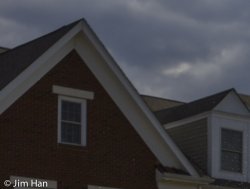Then the D800, which has 36.3 megapixels, has a clear disadvantage, yet it still manages some 800 points higher on DxOMark...
Yes, the D800 has a clear disadvantage, but scores higher regardless of that. The camera which scores highest in the high ISO test is a D3s, though.
What am I supposed to see? (I've compared the test stills at ISO 3,200-12,800.)
I don't see an edge for Canon's at least, in fact, I'd say the D600 and D700 have less chroma noise while the 5D Mark I and Mark II have more. The D800 shows visibly more noise than its Nikon brethren, worse in terms of detail compared to the Canon, but a little less chroma noise. Overall, it seems to me that the D600 and the D4 have the best output. Just to be clear: I would not trust my eyes to give an objective score, but I don't see the advantage that you speak of.
It's a little bit surprising that you prefer the output (in terms of noise, at least) of those cameras which I find the noisiest. Probably that's one of the reasons you shouldn't put too much faith in subjective noise measurements.
There's a reason why people say one should try a camera out before buying; numbers don't reveal everything about a camera.
And about the appearance of noise: Again, as you said, it's a personal preference, a subjective matter. Making numbers represent such things, which is what DxOMark does, is thus impractical.
No, I don't think you should go that far: measurements of noise do give you a clear indication on some properties of a camera just like acceleration figures do with cars. If two cars have the same engine, but one of them is 50 % heavier, it's a clear indication which one will accelerate faster, have better handling, etc. But performance goes beyond that and you cannot put everything into numbers. But in these cases, you
can measure different types of noise, you
can make a clear determination which camera has more and which camera has less noise of a given type.
What you cannot put in numbers is what kind of noise is preferable, that's where the argument gets subjective (for good reason).
Wishful thinking? Far from it. I honestly don't care; ISO 3200 or 6400 is all I'll ever need, and I'm quite satisfied with what Canon can do at those sensitivities.
Bingo, that's exactly the point I was making earlier: know your camera and its limitations, and you will take good pictures.
Sounds a bit like yourself, since neither I nor Redneck said that Canon or my camera is superior to Nikon (it's not, at least in overall stills performance).
I'm just arguing because I get sick of people who mix scientific and unscientific arguments. It doesn't rub me the wrong way because I shoot Nikon, it rubs me the wrong way because I'm a scientist. (BTW, just to be clear, I think my next camera will be a Fuji X-series mirrorless, so I'm not going to invest in a full frame dslr.)
As for everyone else: I know the 5D2's noise performance is decent, so I'm considering it for sports photography. Do you think the autofocus is up to the task?
Seeing as the Mark II uses a slightly tweaked version of the AF module of the Mark I, I don't think the Mark II is a good choice for sports photography. (Meaning it takes more skill to get in-focus images.)



